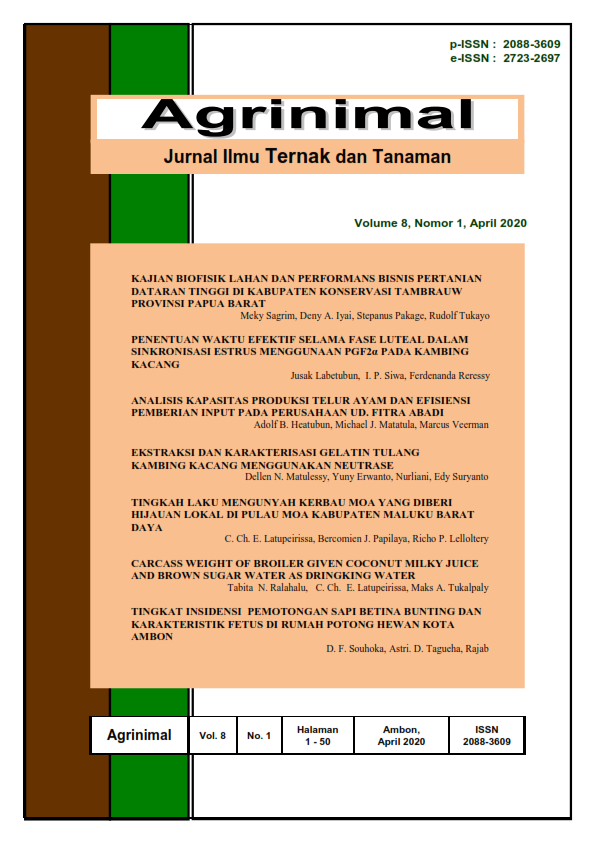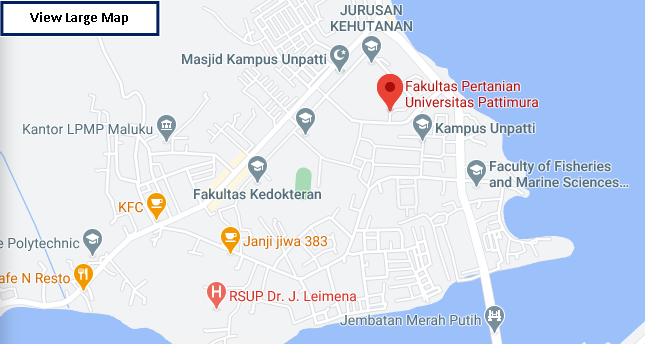EKSTRAKSI DAN KARAKTERISASI GELATIN TULANG KAMBING KACANG MENGGUNAKAN NEUTRASE
Abstract
This study aims was to evaluate the characteristics of the gelatine derivate from Kacang goat bone extracted enzymatically using neutrase at different enzyme concentrations. The neutrase treatments, namely GTK-N0 (gelatin with neutrase 0%), GTK-N1 (Gelatin with 0.25% neutrase), GTK-N2 (Gelatin with neutrase 0.5%) and GTK-N3 (Gelatin with neutrase 0,75%). The bones sample used the bones from local Kacang goat aged 6 to 12 months. The study used was a randomized complete design (Oneway ANOVA) with 4 enzyme concentration treatments with 5 replications each treatment. The parameters observed were gelatin yields, the proximate analysis was performed on goat bones and gelatin (water content, ash, fat, and crude protein), pH, gel strength, viscosity, and functional groups of gelatin FTIR. The results showed that the application of the neutrase enzyme at the 0.25% level had the significant effect on the characteristics of the gelatin produced. The conclusion of this study neutrase can be used for enzymatically extracting gelatin from the bones of local Kacang goat and produced the gelatin characteristics that can be used for food applications.
Downloads
References
Abedinia, A., Ariffin, F., Huda, N. and A. M. Nafchi. 2017. Extraction and characterization of gelatin from the feet of Pekin duck (Anas platyrhynchos domestica) as affected by acid, alkaline, and enzyme pretreatment. International Journal of Biological Macromolecules, 98: 586–594.
Ahmad, M. and Benjakul, S. 2011. Characteristics of gelatin from the skin of unicorn leatherjacket (Aluterusmonoceros) as influenced by acid pretreatment and extraction time. Food Hydrocolloids, 25(3): 381– 388.
Akagündüz, Y., Mosquera, M., Giménez, B., Alemán, A., Montero,P. and M.C. Gómez-Guillén. 2014. Sea bream bones and scales as a source of gelatin and ACE inhibitory peptides. LWT - Food Science and Technology, 55: 579-585.
Almeida, P.F. and S.C.D.S. Lannes. 2013. Extraction and physicochemical characterization of gelatin from chicken by-product, J. Food Process Eng., 36 (6): 824–833.
AOAC. 2000. Official Methods of Association official Analytical Chemist. 12th edition. Publish by Association of Offical of Analytical Chemist.Benjamin Franklin Station. Washington D.C.
Bahar, A., Rusijo, and N. Kusumawati. 2018. The Effect of Curing and Extraction Time against Yield and Quality of Type B Gelatin from Goat Bone. Atlantis Highlights in Chemistry and Pharmaceutical Sciences, 1: 5 – 9.
BPS. 2017. Badan Pusat Statustik Indonesia. www.bps.go.id. Diakses Agustus 2018.
Cebi, C., Durak, M.Z., Toker, O.S., Sagdic, O. and M. Arici. 2016. An evaluation of Fourier transforms infrared spectroscopy method for the classification and discrimination of bovine, porcine and fish gelatins, Food Chemistry, 190: 1109–1115.
Damrongsakkul, S., K. Ratanathammapan, K. Komolpis, and W. Tanthapanichakoon. 2008. Enzymatic hydrolysis of rawhide using papain and neutrase. Journal of Industrial and Engineering Chemistry. 14(2): 202-206. https://doi.org/10.1016/j.jiec.2007.09.010.
Gelatin Manufacturers Institute of America (GMIA). 2012. Gelatin Handbook. Gelatin Manufacturers Institute of America, Inc, New York.
Heu, M.S., Lee, J.H., Kim, H.J., Jee, S. J., Lee, J.S., Jeon, Y.J., Shahidi, F. and J. Kim. 2010. Characterization of acid- and pepsin-soluble collagens from flatfish skin. Food Science and Biotechnology, 19(1): 27–33.
Huang, C., Tsai, Y., Hong, Y., Hsieh, S. and R. Huang. 2018. Characterization and Antioxidant and Angiotensin I-Converting Enzyme (ACE)-Inhibitory Activities of Gelatin Hydrolysates Prepared from Extrusion-Pretreated Milkfish (Chanos chanos) Scale. Marine Drugs, 16, 346; doi:10.3390/md16100346.
Imelda, W.Y. Cheung, Eunice C.Y. Li-Chan. 2017. Enzymatic production of protein hydrolysates from steelhead (Oncorhynchus mykiss) skin gelatin as inhibitors of dipeptidyl-peptidase IV and angiotensin-I converting enzyme. Journal of Functional Foods, 28: 254–264.
Jelita J,, Wirjosentono, B.,Tamrin, T. and L. Marpaung. 2018 Characterization of gelatin from scapula (Os scapula ) from Aceh cattle. https://doi.org/10.1063/1.5082477.
Jellouli, K., Balti, R., Bougatef, A., Hmidet, N., Barkia, A., and M. Nasri. 2011. Chemical composition and characteristics of skin gelatin from grey triggerfish (Balistes capriscus). LWT - Food Science and Technology, 44: 1965–1970.
Kim, H.W., Song, D.H., Choi, Y.S., Kim, H.K., Hwang, K.E., Park, J.H., Kim, Y.J., Choi, J.H. and J. Kim. 2012. Effects of soaking pH and extracting temperature on the physicochemical properties of chicken skin gelatin. Korean J. Food Sci. Anim. Resour, 32: 316-322.
Koli, J.M., Sonavane, A.E., Vishwasrao, V. dan K.H. Pujari. 2018. Functional Properties of Gelatin Extracted From Poultry Skin and Bone Waste. International journal Pure Application Biosci, 6 (4): 87 – 101.
Ktari, N., Bkhairia, .I, Jridi, M., Hamza, I., Riadh, B. S. and M. Nasri. 2014. Digestive acid protease from zebra blenny (Salaria basilisca): Characteristics and application in gelatin extraction. Food Research International, 57: 218–224.
Lassoued, I, Jridi, M., Nasri, R., Dammak, A., Hajji, M., Nasri, M. and A. Barkia. 2014. Characteristics and functional properties of gelatin from thornback ray skin obtained by pepsin-aided process in comparison with commercial halal bovine gelatin. Food Hydrocolloids, 41: 309-318.
Lassoued, I., Mora, L., Barkia, A., Aristoy, M.-C., Nasri, M., and F. Toldrá. 2015. Bioactive peptides identified in thornback ray skin’s gelatin hydrolysates by protease from Bacillus subtilis and Bacillus amyloliquefaciens. Journal of Proteomics, 128: 8–17.
Ling-ling, G., Zhen-yu, W., Zheng, L., Cai-xia, Z. and Z. De-quan. 2018. The characterization of acid and pepsin soluble collagen from ovine bones (Ujumuqin sheep). Journal of Integrative Agriculture, 17(3): 704–711.
Liu, D, Liang, L, Regenstein, J.M. and P. Zhou. 2012. Extraction and characterisation of pepsin-solubilised collagen from fins, scales, skins, bones and swim bladders of bighead carp (Hypophthalmichthys nobilis). Food Chemistry, 133:1441-1448.
Ma, Y., Zeng, X., Ma, X., Yang, R. and W. Zhao. 2019 A simple and eco-friendly method of gelatin production from bone: One-step biocatalysis. Journal of Cleaner Production journal, 209: 916–926.
Moreno-Piraján, J.C., Giraldo, L. and V.S. GarcÃa-Cuello. 2011. Study of the textural properties of bovine bones char under different conditions J. Water Resour. Protein, 3 (3): 176-181.
Muyonga, J. H., Cole, C. G. B., and K.G. Duodu. (2004). Fourier transform infrared (FTIR) spectroscopic study of acid soluble collagen and gelatin from skins and bones of young and adult Nile perch (Lates niloticus). Food Chemistry, 86: 325-333.
Nagarajan, M., Benjakul, S., Prodpran, T., Songtipya, P. and H. Kishimura. 2012. Characteristics and functional properties of gelatin from splendid squid (Loligo formosana) skin as affected by extraction temperatures. Food Hydrocolloids, 29: 389-397.
Norziah, M., Kee, H. and M. Norita. 2014. Response surface optimization of bromelain-assisted gelatin extraction from surimi processing wastes, Food Biosci., 5: 9–18.
Rahman, M.N.A., and S.A.S.K.A. Jamalulail. (2012), Extractions, Physicochemical Characterizations and Sensory Quality of Chicken Feet Gelatin, Borneo Science, 30: 1-13.
Regenstein, J. and P. Zhou. 2007. Collagen and gelatine from marine by-products. In: Maximising the Value of Marine By-Products (edited by F. Shahidi). Cambridge: Woodhead Publishing Limited, 279–303.
Saadaoui, H., Espejo-Carpio, F.J., Guadix, E.M., Amar, R.B. and R. Pérez-Gálvez. 2019. Bi-objective optimization of tuna protein hydrolysis to produce aquaculture feed ingredients. Food and Bioproducts Processing, 115: 26–35.
Sanaei, A.V., Mahmoodani, F., See, S.F., *Yusop, S.M. and A.S. Babji. 2013. Optimization of gelatin extraction and physico-chemical properties of catfish (Clarias gariepinus) bone gelatin. International Food Research Journal, 20(1): 423-430.
Sastrohamidjojo, H. 2001. Spektroskopi. Cetakan kedua. Liberty, Yogyakarta.
See, S. F., Hong, P. K., Ng, K. L., Aida W. M. and A. S. Babji. 2010. Physicochemical properties of gelatins extracted from skins of different freshwater fish species International Food Research Journal, 17: 809–816.
Shyni, K., Hema, G.S., Ninan, G., Mathew, S., Joshy, C.G. and P.T. Lakshmanan. 2014. Isolation and characterization of gelatin from the skins of skipjack tuna (Katsuwonus pelamis), dog shark (Scoliodon sorrakowah), and rohu (labeo rohita). Food Hydrocolloids, 39: 68–76.
Songchotikunpan, P., Tattiyakul, J., & Supaphol, P. 2008. Extraction and Electro-Spinning of Gelatin from Fish Skin. International Journal of Biological Macromolecules, 42: 247 – 255.
Steel, R.G.D. and J.H. Torrie. 1993. Prinsip dan Prosedur Statistika, Suatu pendekatan Biometrik. Penerjemah: B. Sumantri. Gramedia Pustaka Utama, Jakarta.
Standar Nasional Indonesia (SNI). 1995. Mutu dan cara uji gelatin. SNI 01-3735. Jakarta.
Sumantha, A., Larroche, C., & Pandey, A. (2006). Microbiology and industrial bio- technology of food–grade proteases: A perspective. Food Technology and Biotechnology, 44(2), 211–220.
Tavano, O.L. 2013. Protein hydrolysis using proteases: An important tool for food biotechnology. Review. Journal of Molecular Catalysis B: Enzymatic, 90:1–11.
Widyasari, R. and S. Rawdkuen. 2014. Extraction and characterization of gelatin from chicken feet by acid and ultrasound assisted extraction, Food Appl. Biosci. J., 2 (1): 85–97.
Zhang, Y., Dutilleul, P., . Li, C. and B.K. Simpson. 2019. Alcalase-assisted production of fish skin gelatin rich in high molecular weight (HMW) polypeptide chains and their characterization for film forming capacity Lwt- Food Science and Technology, 110: 117–125.








